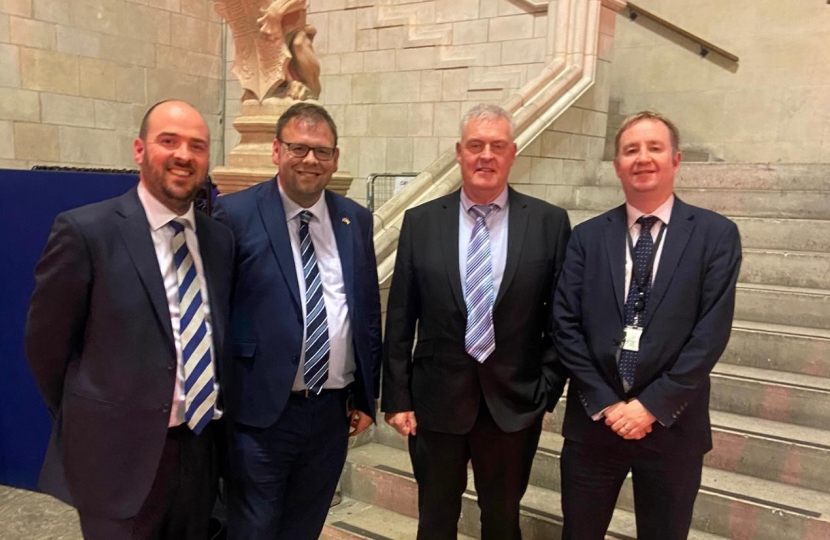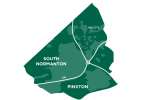
Junction 28 in its current state is not fit for purpose. Residents in South Normanton and Pinxton continue to experience congestion on a daily basis and only 9% of people in my recent survey said they thought the junction is ‘safe’ or ‘very safe’.
Today I held a Westminster Hall debate supported by my honourable friends the MP for Ashfield, Lee Anderson, and the MP for Amber Valley, Nigel Mills, to put forward the case for funding to Richard Holden MP, Minister for Roads and Transport. The need is clear, whether that’s road safety, economic development, reducing congestion and emissions, or lowering costs from delays to local businesses.
I know the Secretary of State understands the importance of this vital infrastructure project to our region and I look forward to working with the Government to deliver for local residents.
You can watch the debate here: Pinxton Interchange - J28 - Westminster Hall Debate - YouTube
I beg to move,
That this House has considered the potential merits of improvements to junction 28 of the M1.
It is a pleasure to serve under your chairmanship, Ms McVey, and I hope that today’s discussion is suitably blue-collar for you.
I am absolutely delighted to be joined by my neighbours, my hon. Friends the Members for Ashfield (Lee Anderson) and for Amber Valley (Nigel Mills). I send the apologies of my hon. Friend the Member for Mansfield (Ben Bradley), who is unfortunately unable to be in Westminster Hall today. However, I know that he is incredibly supportive of the discussions that we are about to have and the case that we are about to make.
I am particularly delighted to see that the Under-Secretary of State for Transport, my hon. Friend the Member for North West Durham (Mr Holden), is responding to the debate and I will pre-emptively butter him up. I know that he very much shares my passion for investing in roads and infrastructure, and for levelling up. He also understands the importance of the Bolsover constituency to this country; I look forward to his just signing off on this project on an ad hoc basis.
I was elected on a manifesto that was about levelling up places such as Bolsover. The former mining communities that I represent are a hidden gem in the heart of England. We are blessed with great people and great potential, but there is a need to unlock some of that great potential. We have low unemployment locally, but average wages are low and many jobs are low-skilled. I want to deliver high-skilled, high-wage jobs and allow every young person in my constituency to fulfil their potential. The essential ingredients for levelling up are good infrastructure and transport links, which I will return to, good housing stock, a skilled and educated population, and skilled jobs and investment—all underpinned by a culture of aspiration. The Bolsover constituency is fortunate to sit close to Sheffield, Derby and Nottingham—all cities undergoing a renaissance, with the East Midlands airport and a soon-to-arrive freeport attached, and major companies such as Rolls-Royce powering the regional economy—but that means nothing if residents and businesses cannot get to and from those places due to inadequate transport links.
I am here to make the case primarily on behalf of the residents of South Normanton and Pinxton for the long-overdue upgrade of junction 28 of the M1. I say “primarily”, because a wide-ranging list of stakeholders supports the upgrade of the junction, including, but not limited to, the Conservative county council leader, the Co-operative Group, National Highways, the Labour district council leader, local district councillors, local parish councillors, Councillor Julian Siddle, the county councillor for South Normanton and Pinxton, Midlands Connect, a McDonald’s franchise and dozens of other businesses, not to mention the thousands of people inconvenienced by the junction every day, not all of whom live in the Bolsover constituency.
Junction 28 of the M1 was built in 1967 as the key strategic node linking the M1 and the A38, connecting north and south, the east and west midlands, and facilitating the movement of goods and services between local, regional and nationwide locations. Locally, it links South Normanton and Pinxton to the motorway network and the A38, which, heading eastwards, goes past various major distribution and business parks as well as the McArthurGlen shopping centre outlet, before leaving the safe confines of Derbyshire, a mile or so down the road, and entering Nottinghamshire, first into Ashfield and then into Mansfield. Heading westwards along the A38, a person will soon reach Ripley, then Derby and then the west midlands and Staffordshire, beginning with Burton upon Trent.
This junction of major strategic importance acts as the gateway to the south of my constituency, including communities such as Tibshelf, Newton, Blackwell, Pilsley and Morton. It also acts as a major logistics and employment hub for the whole region, yet it is simply not fit for purpose and is over capacity. When it comes to safety, delays, air pollution or reliability, junction 28’s design is causing problems. It is an all-too-familiar sight, particularly for those of us travelling south from places such as Clowne, where I live, to see the signs approaching junction 2 state: “Queues on sliproad”. It is not infrequent that the queues stretch back to Tibshelf services, three miles back from the junction.
As one constituent wrote to me,
“I’ve had several incidents on my way to work, where I was forced to join the back of queuing traffic that extended from the junction slip road on to the slow lane of the M1 motorway. Many cars were using the hard shoulder to queue, to avoid being stationary on the M1 itself. It was evident to me that the stationary vehicles were being passed by cars and lorries travelling at high speed. The risk of injuries or death from a multi-vehicle collision is very high.”
That sense of danger when using the junction is almost ever-present. Twenty-nine per cent. of local residents said their experience of the junction was very unsafe, and 41% said it was unsafe. Tellingly, only 1% said it was very safe.
The situation is no better from the northbound carriageway. Queues often trail back on to main carriageway. One resident, Emma, from South Normanton, who uses the junction every day, wrote in her survey response:
“the daily situation of queuing on the M1 northbound to get on to the slip road is very dangerous and has been shown as such with the recent serious accidents.”
Residents often tell me that they avoid the roundabout as it is unsafe, with one even describing it as “treacherous”. This sense of fear plays out in the data. There have been 16 serious accidents—the highest category—in the past 10 years. Many other minor scrapes and near misses are not recorded, but anyone who has used the junction, particularly heading into South Normanton on Mansfield Road, will know how dangerous it can feel.
Councillor Julian Siddle, who shares my passion for upgrading the junction, sent me a note ahead of the debate, highlighting how the problems have been aggravated in recent years. A lot of new housing has been built locally and a number of new businesses have understandably invested in the area, such as the Panattoni park complex. It joins others like Alloga and the McArthurGlen shopping outlet, which have expanded locally. That is not to mention that attractions like the Peak District have grown in popularity, all increasing usage of the junction and the surrounding areas. Some parts of the network have been improved to cope with these pressures, such as the A38 around Derby and the move to make the M1 four lanes—albeit under a smart motorway scheme that
I think local residents would prefer to do without—but this junction connecting those critical roads remains outdated.
The stationary traffic has a huge impact on local air quality. South Normanton has been an air quality management area since 2001. That was fortunately removed in March last year because of improvements to vehicle emissions, but as a letter from South Normanton parish council said last year,
“the queuing caused by this junction is nothing short of an environmental disaster for the local people”
—a sentiment I hear regularly across South Normanton and Pinxton. The same letter points out that the knock-on effects of the queuing mean that drivers take alternative routes that can become rat runs, which are often close to the local schools. I hasten to add that Pinxton also suffers tremendously from the number of heavy goods vehicles that travel through it, causing air and noise pollution—though that is a slightly separate argument from the one I am making today.
This issue becomes more acute for residents when there are problems or works on the network. Any issue south of junction 28 sees a diversion towards Derby on the A38. Maintenance work or accidents on the A38 see traffic diverted through South Normanton. More than once I have seen the entire region become one long traffic jam. Alongside these dangers and inconveniences for local residents, an economic cost is involved. There are delays to the traffic heading north and south on Britain’s main motorway and east and west on the main arterial route that connects the east and west midlands, not to mention the impact that the congestion has on the wider region around Bolsover, Chesterfield, Ashfield and Mansfield.
I am extremely grateful to the team at Midlands Connect, who work across the midlands on behalf of the Government to recommend the most important transport investments to the Secretary of State. Midlands Connect has recognised that improving junction 28 is a priority and has been working proactively with me on putting the case forward for the necessary investment. It has produced the following data, which helps underline the strong case for investment. Analysis by Midlands Connect shows that delays at junction 28 of the M1 lead to over 1,100 hours of delays every day at peak times. Simply, in monetary terms, that costs the local and national economy over £4.5 million a year. Thousands of pounds every day are being lost from unnecessary delays, and many stakeholders have identified issues with that junction as a barrier to investing in our constituencies. In an independent survey, over half of the residents of South Normanton and Pinxton thought that improvements to the junction would be “very important” to businesses.
The Co-operative Group has a major depot just off the junction. In a letter to me in April last year, it said it makes around 135,000 vehicle movements through junction 28 in a year. It estimates that the average four-minute waiting time per vehicle amounts to 9,000 lost hours, or 900 driver shifts, that could be saved by making improvements. Strata Products, which has a factory in Pinxton and a warehouse just off junction 29 in Holmewood, in my constituency, runs an average of 12 return trips between the two every day. It believes that the delays at junction 28 add five minutes per trip, costing the company two hours of productivity every day. Those are just two examples, but there are hundreds of businesses located in the area, and the delays are costing our economy so much money.
As an aside—I appreciate that this is slightly wide of the debate’s scope—junction 29, in my constituency, is another junction in desperate need of improvement; the residents of Holmewood, Heath, Bramley Vale, Doe Lea and Glapwell, and particularly Councillor Suzy Cornwell, would not forgive me if I did not mention that. The case for improvements is not the issue with the junction; rather, it suffers from two complications: the walkways that run underneath the junction, which affect the design, and the land that surrounds the junction, which is currently tied up, somewhat ridiculously, by High Speed 2 safeguarding on a line that we all know is dead.
I hope that the Minister will be in post for a very long time so that he will be present at a future debate on junction 29, in which I can make similarly thrilling arguments to him. However, both National Highways and Derbyshire County Council are aware of the overwhelming case to improve the junction, and I will continue to work with both of them in the meantime.
I return to the delays at junction 28, which are costing the economy £4.5 million a year and deterring investment locally. Vitally, that is happening in the context of economic research showing that the gross value added per head and job density in the districts nearest to junction 28, which are represented in the Chamber today, are lower than the east midlands average and significantly below the UK average. Indeed, Bolsover is the most deprived district in Derbyshire. I know that the Minister shares my passion for levelling up, and improvements to junction 28 clearly fall into that category. Indeed, in an independent survey, 80% of local residents said that they saw improvements to the junction as levelling up in action.
The Department for Transport will soon receive a whole range of bids for projects to be part of RIS3, or tranche 3 of the road improvement scheme. It will not surprise the Minister that I think junction 28 should be top of the pile, and if he feels inclined to skip the process and approve it today, I will be very happy to accept that.
In 2021, initial projections by National Highways, which was then known as Highways England, showed that £21 million of investment in junction 28 could deliver benefits of around £150 million, although those figures are now two years out of date and the former probably needs updating to closer to £30 million due to inflation. Based on the economic delay figures outlined today, we would be looking at a return of investment in around five to six years. The project has a very solid benefit-to-cost ratio, and it clearly makes commercial sense to improve the junction.
As an aside, it is slightly ludicrous that we rely so heavily on central Government for regional transport issues, and on funding over such long timeframes. My constituents would like to see junction 28 improved today, but unfortunately we will be involved in a process that takes a number of years. I am just one of many MPs in the east midlands who support a devolution settlement for our region, which would unlock a lot of additional funding for the region and help to provide a more convenient approach to investment and infrastructure through a regional mayor.
Perhaps central Government should be involved in a project such as junction 28, where we are talking about investment of £20 million to £30 million, although that seems too low a threshold. However, on the other side of Whitwell, in my constituency, sits Darfoulds bridge, where the road simply needs lowering to prevent HGVs from taking detours through small villages. The project will cost around £2 million—too much for our local authorities, but too little for central Government—yet the benefits would be extraordinary for businesses and residents. I hope the creation of a regional mayor will help to unlock the stalemate.
Since being elected, I have worked solidly on improving junction 28. I have met National Highways several times, I meet our local authorities regularly, I have bothered Ministers until I am blue in the face, and I have spoken continuously to Midlands Connect. I have surveyed local residents, held a business roundtable, collated business testimony and brought together the case that I have presented today.
There is a real case for the Minister to consider. This is an affordable scheme, it is popular—84% of local residents support it—it has a strong business case, it will help investment and save us from losing £4.5 million per year, it is supported by many local MPs, councillors and business groups, and it will help the environment. Barry Lewis, the leader of Derbyshire County Council, says:
“We wholeheartedly support the bid for Government funding to keep this part of Derbyshire moving by easing congestion to improve journey times for businesses, commuters, residents and visitors alike and cut carbon emissions generated by vehicles caught up in lengthy queues.”
This is the sort of levelling up the Minister could and should be delivering. On behalf of the residents of Pinxton and South Normanton, I say: let us get this done.





